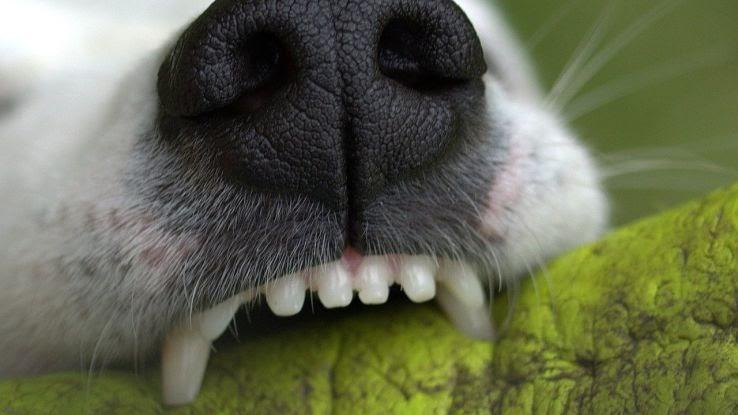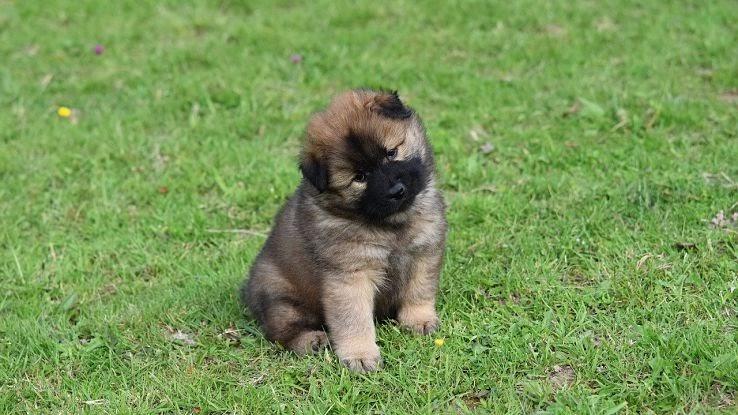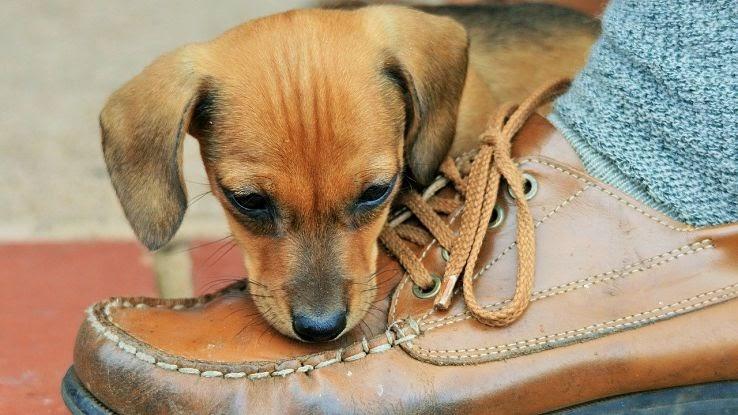How to Draw a Dog Bowl Step by Step

Man's best friend has a funny way of communicating sometimes, but almost everything your dog does has meaning. From barking to whining, jumping to butt scooting, your dog's actions are something you should pay close attention to.
Learning about your dog's behavior is one of the best ways you can care for your four-legged pal. While most things your pup does are nothing to worry about, noticing the signs and symptoms that something may be wrong are very important.
The Play Bow
A play bow is when your pup is crouched down in the front with his backside up in the air. The position usually signifies that your four-legged friend wants to play, and it allows your pet to run quickly at a moment's notice.

A play bow invites another dog or a human to interact and, as the name suggests, play. While a dog may growl or bark while in the play bow position, the pup's body language is meant to show you that it just wants to have some fun.
It's no secret that dogs love to dig. Some want to dig in the dirt to try and find a buried treasure, and some dig just because they're bored. While digging is usually not harmful to a pup, you may want to deter your dog from doing so because your pet may get dirty or start digging in places that are off limits — like your garden.

Many canine professionals will tell you that a dog that digs is one that needs to get some additional exercise. If you have a digger in your clan, spend some more time playing fetch.
Chewing
If your dog is chewing on just about everything in sight, chances are that the animal is having an issue with its teeth. Puppies chew when they are teething, so it's important to make sure you have plenty of toys available, including bones and other teething-specific toys.

Even older dogs enjoy chewing — it's just part of being a dog. However, if you don't provide discipline early on, you may find some of your belongings completely destroyed. Make sure you introduce plenty of chewing options, and be stern when it comes to deterring your pup from chewing on things like the furniture.
Begging
You may notice your dog hanging around the dinner table looking all kinds of desperate for a taste of human food, but you should resist. Dogs that are given a taste of food from the table will almost always beg for more. They may begin to whine or bark while looking anxiously up at the table.

If the begging is getting out of hand, you may want to crate your pup or put it outside until the meal is over. However, it's best to avoid this altogether by not offering any table food in the first place.
Pulling on the Leash
A dog that pulls on the leash while on a walk needs training. The behavior is usually caused by a dog being over-excited for a walk. Getting exercise shouldn't be a stressful event for you or your dog, so this behavior needs to be squashed as soon as possible.

The best way to do this is by keeping the leash short but loose. When your dog pulls and the leash goes tight, you should stop walking. Your dog should also stop once it realizes you're not moving. Make sure you use positive reinforcement by way of treats.
Whining
A dog's whine can mean a few different things. Most of the time, a whining dog just wants your attention. If your dog starts whining and you immediately give the animal attention, however, you are demonstrating that whining will get your pet that attention. You should avoid doing this and only give your dog attention when it is not whining.

A dog that is in pain may also whine, so it's important to make sure you pay attention to your dog. If you notice any other signs of pain, a trip to the vet may be in order.
Separation Anxiety
If your dog gets upset when you leave, it probably has separation anxiety. Since you are your dog's whole life, it is important to teach your pet that you aren't gone forever and will come back.

In the event this is happening to your dog, you may want to try leaving for shorter periods of time, working up to longer times away. Sometimes leaving the television or radio on while you are gone can help as it makes it seem like people are talking in the house. Overall, this is very common and not a cause for concern.
Barking at the Door
A dog that barks at the door may want to go outside. To avoid a potty accident, you should take your dog outside. Dogs may also bark at the door if they want to go outside to play, in which case you could appease your pup and go for a run.

Dogs also bark at the door if they sense that someone is outside. This can be an excellent way for a dog to alarm you that company has arrived. If the barking is excessive, you may want to talk to your vet.
Jumping
Dogs and jumping often go hand-in-hand. Dogs jump when they are happy, mainly because they are excited to greet another being. However, jumping is often frowned upon because a lot of people — especially strangers — do not want to be greeted with such enthusiasm.

To keep your dog from jumping, be sure not to give the animal attention unless all four paws are on the ground. You may also tell your pup to sit before allowing someone to come over and pet it. These things can significantly help control your pup's excitement, making meet and greets far more enjoyable for everyone.
Biting
Biting is how dogs protect themselves. No matter how calm a dog's disposition is, a moment of aggression or fear can turn ugly quick. A dog that bites likely feels threatened or nervous. Ideally, these feelings should be faced head-on from a young age.

Dogs should be socialized in a comfortable setting where they do not feel intimidated. Frequent trips to a dog park or pet store help with adjusting to new scents and making friends. It's important not to put your dog in any situation where the animal feels unsafe to keep potential biting at bay.
Excessive Barking
A barking dog is inevitable since that's how canines communicate. But what happens when your dog barks excessively? Your dog could be experiencing anything from frustration to aggression to a desire to play.

Excessive barking can be annoying. Once you determine that there is nothing wrong, you can work to correct this behavior. If a dog barks excessively, the animal is trying to tell you something, but perhaps not in the most convenient way. Obedience training can help. Being consistent in training is vital, as a dog will learn to pick up on whatever cues you offer it.
Butt Scoot
If your dog is scooting his butt across the carpet, there could be a multitude of things going on. A dog may drag its behind if it's itchy or something is stuck there. In these instances, there's nothing to worry about.

A dog may also scoot his butt if there's something more serious going on. This could signify that your dog has worms or anal gland issues. If the behavior continues, you should call your vet. If you suspect your dog's anal glands are the issue, your groomer should be able to help.
Growling and Baring Teeth
When dogs bare their teeth and growl, they are showing aggression. Your dog may express these feelings toward another dog or a human. Whatever the source, you should keep your dog away from whatever the animal is fixated on. You should not allow your dog to approach another animal or human if this behavior is present.

While you can try to calm your dog by providing a distraction or speaking in a soothing tone, it's important that you are careful as well. If you interfere at the wrong time, you could get bitten.
Howling
If your pooch hears something high-pitched, like a train whistle, it may try to match the sound by howling. This may be because the sound annoys the dog or hurts the animal's ears.

It's also possible that your dog is trying to express itself in a different way. Some dogs howl when they are sad or lonely, which can be absolutely heartbreaking. Some dogs howl to mimic humans, like when they are singing or laughing.
Low Growl
A dog may express a low growl if it hears something but is unsure what it is. You may notice that your dog low growls while looking out the window. Perhaps the animal sees something but is not quite sure if it's a threat or not.

A low growl may also signify that your dog is anxious or fearful. You should speak to your pup in an upbeat tone and try to distract it from whatever is causing anxiety. Try to encourage your pet or even as it to do some tricks to take the pup's mind off of the fear.
Superman
A dog gets in the Superman position when it is completely tuckered out but very comfortable. The Superman pose is apparent as the animal has its front paws stretched out and back paws sprawled straight back. The position is seen in dogs of all ages, but it's most often seen in puppies.

A dog sleeping in the Superman position isn't on high alert and is totally relaxed. It's difficult for a dog to be on guard when laying like this, so you know you have one super tired, super chill pup if you find your dog sleeping in this position.
Giving Gifts
Dogs bring gifts to their owners as a way to show affection. Your dog is trying to make you happy by bringing you something special. Most of the time, the dog will bring something from around the house, like your slippers or a favorite toy. However, sometimes you aren't lucky and your dog brings you a dead animal, such as a mouse.

Sure, this isn't ideal, but the sentiment is still positive. Your dog wants you to know that it loves you and is loyal. Your pet wants nothing more than to make you proud.
Licking
Licking is a dog's love language. Your four-legged bestie may shower you with kisses as a way to show you're its favorite. A dog kissing session can last a long time if you allow it, and it can be a daily occurrence. There's nothing wrong with a dog showing affection, although some people get grossed out by it.

Your dog may take every opportunity to kiss you on the hand, arm, face and even your mouth. Your dog's love has no boundaries, so if you'd prefer to skip the mouth licks, you'll have to pull away.
Licking or Biting Paws
While licking a human to show love is a beautiful thing, a dog who licks his own paws could be experiencing something that requires a trip to the vet. A dog that licks its paws after eating may be experiencing a food allergy. Alternatively, a dog that licks or bites its paws on a regular basis could be experiencing anxiety.

It's essential to pay attention to when your dog licks its paws and report that information to your vet. Excessive licking can cause wounds, and that could lead to an infection, so do not take paw licking lightly.
Sneezing
Dogs sneeze due to irritants inhaled into their noses, not unlike humans. They can also sneeze from allergies caused by grass and pollen. While most sneezing in canines is nothing to worry about, a dog that sneezes excessively or with discharge could require a visit to the vet.

For example, nasal mites cause sneezing and some unpleasant nasal discharge. Mites are contagious and can be transmitted from dog to dog, so it's important to get your pup checked out as soon as possible if you think there's something else going on.
Head Tilting
Just about everyone knows all about the dog head tilt that will undoubtedly melt your heart. Have you noticed that when you talk to your dog, it looks right at you and tilts its head? This is the animal being curious. Dogs tilt their heads as a way to adjust their outer ears so that they can hear you better.

A dog that tilts its head while you talk is hanging onto every word coming out of your mouth. Your pet is attentive and wants to know if you have anything to say — especially if it involves a trip to the park!
Butt Sniffing
While most of the things that dogs do are cute, there are a couple that simply aren't. You may even say they're gross. That brings us to the butt sniff. If your dog meets another dog and immediately sniffs its butt, this is totally normal.

A butt sniff is the equivalent of a human shaking another human's hand. Your dog is trying to get to know another dog — or a human. Yes, dogs sometimes sniff human butts, too.
Chasing Their Tail
Ah, the tail chase. A favorite pastime of so many doggos. Dogs chase their tails for a variety of reasons, but most of the time, it is all in good fun. A puppy may chase its tail because it doesn't realize it's attached to the dog's own body body. An older dog may chase its tail just because the animal is goofy and being playful.

However, this also happens when something else going on. It's possible that your dog has fleas needs its anal glands checked and examined, especially if tail chasing is a frequent occurrence.
Eating Grass
Does your dog eat grass whenever it's outside? While this behavior is normal, it is a cause for concern. Most of the time, a dog eats grass for one of two reasons. Your pet is either missing a specific nutrient in its diet or trying to make itself vomit. The worst-case scenario? The dog has intestinal worms.

No matter what the reason may be, eating grass is not a good thing. You should talk to your vet about your pup's diet and overall health if the dog is eating grass every time you go for a walk.
Eating Feces
A dog that eats its own feces is most likely on a medication that isn't digesting properly. If this medication comes out in the dog's stool, the animal may be enticed to gobble it back up, which is nothing short of gross.

Some mother dogs eat their puppies' feces in an effort to keep the babies clean. While eating feces isn't considered harmful (unless your dog has worms), you should deter your dog from doing this. If you are outside, pick up your dog's poop right away. If your dog uses a pad, try to distract the animal right after it poops.
Humping
Dog humping isn't usually a cause for concern. Some dogs mount or hump in a sexual manner even after being neutered or spayed. Dogs instinctively practice the behavior, especially if they are unaltered. Dogs may also hump as a way of flirting.

While some people think that dog humping is a sign of hormones, this behavior is often a way of exerting dominance. Your dog may hump another dog, a human or even a toy, but it's usually nothing to be concerned about, even if it is super embarrassing.
Sitting or Sleeping on Your Feet
Do you ever notice that your dog is continually touching you? Whether your pet is lying right next to you or cozying up at your feet, this is entirely normal behavior. The dog not only wants you to know that it's there, but it also wants to make sure it knows if you leave. By resting on your feet, the dog will be forced to wake up if you get up from your seat.

A dog resting on your feet may also be a way to mark her territory. You are the dog's human, and the animal wants everyone to be clear on that.
Raising a Single Paw
Dogs are very intelligent creatures, and they try to communicate however they can. If your dog raises a single paw in your presence, it could be requesting your attention. Nine times out of 10, your dog does this to let you know that it wants to play.

However, your dog may also raise its paw because it wants you to pet it. You'll know this because the animal will likely put that raised paw on your arm. The moment you stop petting, the paw will pop up again. Your pet may also do this to let you know that it's hungry.
Barking or Moving Paws While Sleeping
A dog that moves its paws or barks in its sleep is most likely having a vivid dream. If your dog is laying on its side and its feet are moving, the animal is likely dreaming about chasing a bunny rabbit through a field or something similarly exciting.

Most of the time, a dreaming dog is nothing to worry about. If you notice that your dog's stature is more rigid, however, it's possible that it's having a seizure. If you are worried, gently try to wake the dog up. Dogs can be roused relatively easily from a deep sleep, but do not wake them up if you think they're having a seizure.
Yawning
Yawning isn't a behavior that is hard to figure out. Like humans, dogs yawn when they are tired. Dog yawns tend to be extremely cute and can even be highlighted with a bit of a bark. Dogs may also yawn if you yawn, which further proves the theory that yawning is contagious.

There isn't too much to worry about when your pooch lets out a big yawn. It may be time to let the dog chill for a bit and catch up on some much-needed shuteye. Being a dog is just so ruff. See what we did there?
Source: https://www.faqtoids.com/lifestyle/does-your-dog-do-this-find-out-what-it-means?utm_content=params%3Ao%3D740006%26ad%3DdirN%26qo%3DserpIndex
0 Response to "How to Draw a Dog Bowl Step by Step"
Post a Comment